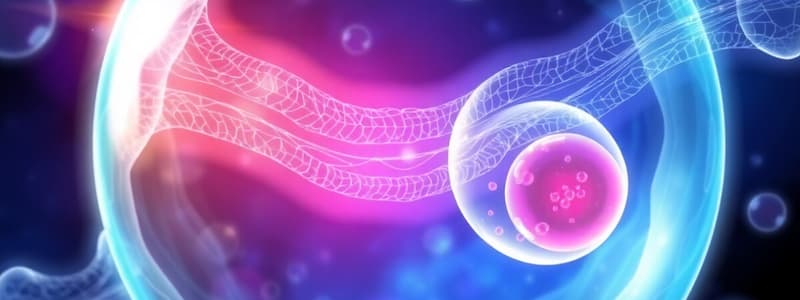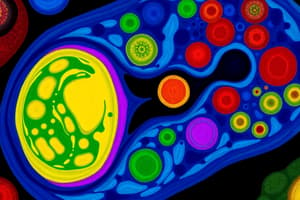Podcast
Questions and Answers
What is the primary role of the dermomyotome in somite development?
What is the primary role of the dermomyotome in somite development?
What congenital anomaly is characterized by the failure of the forebrain to divide?
What congenital anomaly is characterized by the failure of the forebrain to divide?
During which week of human development is neurulation typically completed?
During which week of human development is neurulation typically completed?
What is the primary consequence of X-inactivation in female embryonic development?
What is the primary consequence of X-inactivation in female embryonic development?
Signup and view all the answers
Which signaling pathways are identified as critical in the differentiation of PGCs into gametes?
Which signaling pathways are identified as critical in the differentiation of PGCs into gametes?
Signup and view all the answers
What is the main purpose of germ cell formation during embryonic development?
What is the main purpose of germ cell formation during embryonic development?
Signup and view all the answers
At which stage are primordial germ cells (PGCs) first specified in the early embryo?
At which stage are primordial germ cells (PGCs) first specified in the early embryo?
Signup and view all the answers
Which signaling molecules are crucial for the induction of primordial germ cells?
Which signaling molecules are crucial for the induction of primordial germ cells?
Signup and view all the answers
What type of cells do primordial germ cells differentiate into during gametogenesis?
What type of cells do primordial germ cells differentiate into during gametogenesis?
Signup and view all the answers
Flashcards
Germ Cells
Germ Cells
Specialized cells responsible for producing sperm and egg cells, essential for reproduction.
Gametogenesis
Gametogenesis
The process of germ cell formation, where precursor cells develop into functional sperm or egg cells.
Primordial Germ Cells (PGCs)
Primordial Germ Cells (PGCs)
The earliest precursors of sperm and egg cells, set aside early in embryonic development.
Epiblast
Epiblast
Signup and view all the flashcards
Induction of PGCs
Induction of PGCs
Signup and view all the flashcards
BMPs (Bone Morphogenetic Proteins)
BMPs (Bone Morphogenetic Proteins)
Signup and view all the flashcards
Migration of Primordial Germ Cells
Migration of Primordial Germ Cells
Signup and view all the flashcards
Stromal Cell-Derived Factor-1 (SDF-1)
Stromal Cell-Derived Factor-1 (SDF-1)
Signup and view all the flashcards
Germ Cell Reprogramming
Germ Cell Reprogramming
Signup and view all the flashcards
X-inactivation in Females
X-inactivation in Females
Signup and view all the flashcards
Gonadal Signaling
Gonadal Signaling
Signup and view all the flashcards
Retinoic Acid (RA) in Meiosis
Retinoic Acid (RA) in Meiosis
Signup and view all the flashcards
Germ Cell Sex Determination
Germ Cell Sex Determination
Signup and view all the flashcards
Sertoli Cells
Sertoli Cells
Signup and view all the flashcards
Leydig Cells
Leydig Cells
Signup and view all the flashcards
Granulosa Cells
Granulosa Cells
Signup and view all the flashcards
Spermatogenesis
Spermatogenesis
Signup and view all the flashcards
Oogenesis
Oogenesis
Signup and view all the flashcards
Neurulation
Neurulation
Signup and view all the flashcards
Neural Plate
Neural Plate
Signup and view all the flashcards
BMP Inhibitors
BMP Inhibitors
Signup and view all the flashcards
Neural Plate Elongation
Neural Plate Elongation
Signup and view all the flashcards
Neural Folds
Neural Folds
Signup and view all the flashcards
Neural Groove
Neural Groove
Signup and view all the flashcards
Neural Crest Cells
Neural Crest Cells
Signup and view all the flashcards
Holoprosencephaly
Holoprosencephaly
Signup and view all the flashcards
Sirenomelia
Sirenomelia
Signup and view all the flashcards
Neurulation (Week of Occurrence)
Neurulation (Week of Occurrence)
Signup and view all the flashcards
Somitogenesis
Somitogenesis
Signup and view all the flashcards
Somites
Somites
Signup and view all the flashcards
Dermomyotome
Dermomyotome
Signup and view all the flashcards
Sclerotome
Sclerotome
Signup and view all the flashcards
Notch Signaling Pathway
Notch Signaling Pathway
Signup and view all the flashcards
Mesoderm Segmentation
Mesoderm Segmentation
Signup and view all the flashcards
Cranial-to-Caudal Direction
Cranial-to-Caudal Direction
Signup and view all the flashcards
Somite Formation Rate
Somite Formation Rate
Signup and view all the flashcards
Total Number of Somites
Total Number of Somites
Signup and view all the flashcards
Somite Formation Completion
Somite Formation Completion
Signup and view all the flashcards
Intraembryonic Coelom
Intraembryonic Coelom
Signup and view all the flashcards
Somatic Mesoderm
Somatic Mesoderm
Signup and view all the flashcards
Splanchnic Mesoderm
Splanchnic Mesoderm
Signup and view all the flashcards
Vasculogenesis
Vasculogenesis
Signup and view all the flashcards
Angioblasts
Angioblasts
Signup and view all the flashcards
Hemocytoblasts
Hemocytoblasts
Signup and view all the flashcards
Yolk Sac
Yolk Sac
Signup and view all the flashcards
Study Notes
Gastrulation: Formation of Germ Cells
- Germ cells (sperm and eggs) are essential for reproduction, ensuring species continuation
- Germ cell formation, called gametogenesis, involves differentiating precursors into functional gametes
- Germ cell formation in humans begins during early embryogenesis
- PGCs are precursors to mature sperm and eggs, distinct from somatic cells
- PGCs are specified in the epiblast during the third week of development
- PGC specification is induced by extra-embryonic mesoderm signals (BMPs, Wnt)
- PGCs migrate from the epiblast to the gonadal ridges
- Chemotactic signals (like SDF-1) guide PGC migration through the hindgut and dorsal mesentery
- PGCs avoid apoptosis to reach their destination in the gonads
- In the gonads, PGCs proliferate and differentiate into mature germ cells (spermatogonia or oogonia)
- Gonads are initially sexually indifferent, but develop into testes (males) or ovaries (females) based on genetic and hormonal signals
- SRY gene on the Y chromosome triggers testes formation in males
- Absence of SRY gene results in ovary formation in females
Stages of Germ Cell Formation
-
Primordial Germ Cell Formation (PGCs):
- PGCs are precursors to mature germ cells
- They are distinct from somatic cells, set aside for generating gametes
- PGCs are first specified in the epiblast of the early embryo (third week)
- PGCs are initially undifferentiated
-
Induction of PGCs:
- Primarily driven by extra-embryonic mesoderm signals (BMPs, Wnt)
- Signaling molecules induce the expression of important transcription factors (Prdm1 and Prdm14) for PGC specification
-
Migration of PGCs:
- PGCs migrate from the epiblast to gonadal ridges
- Chemotactic factors (e.g., SDF-1) direct migration
- PGCs must avoid apoptosis during migration to reach the gonads properly
-
Colonization of the Gonads (Gonadal Development):
- PGCs undergo proliferation and differentiate into mature germ cells (spermatogonia/oogonia) upon reaching the gonads
- This stage is the transition from germ cells to gametes
- Sex-specific differentiation marks the start of gametogenesis
Studying That Suits You
Use AI to generate personalized quizzes and flashcards to suit your learning preferences.
Related Documents
Description
Explore the intricate process of gastrulation and the formation of germ cells during early embryogenesis. This quiz covers the specification, migration, and differentiation of primordial germ cells (PGCs) as they develop into mature sperm and eggs. Test your knowledge on the signals and mechanisms that guide this essential reproductive process.




